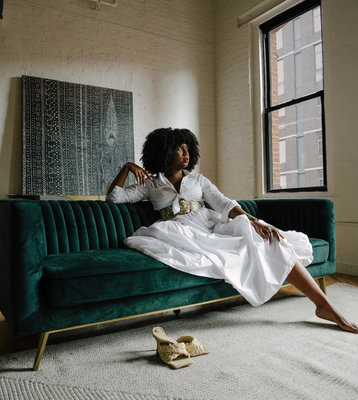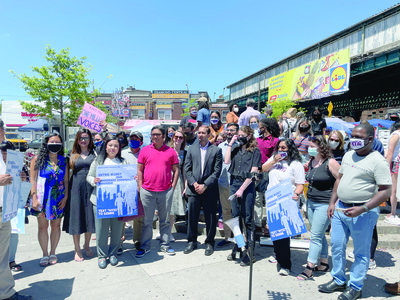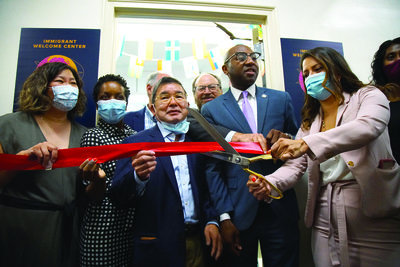Pop-up gallery celebrates Black artists, Juneteenth
Nestled in a cozy studio atop the Brooklyn Space Modern Furniture Building in DUMBO, a new pop-up art gallery titled “What It Feels Like” showcases the work of emerging and talented Black artists.
Arriving just in time for the Juneteenth holiday, the gallery celebrates the individual and collective experiences of Black artists and creatives, including those of the show’s curator Nicolette McClendon.
“The show really came about as a happy accident,” McClendon explained in an interview last week.
Although she went to art school and worked as an artist in her native Miami for ten years, McClendon was working at a corporate fashion company for over ten years when the pandemic began last spring.
As the world went into lockdown, the company McClendon worked for filed for bankruptcy, a twist of fate that proved to be a blessing. She began working on art once again, pursuing freelance work and organizing collaborative projects with other Brooklyn-based artists.
“The pandemic reignited a passion that I didn’t have time for before,” McClendon said. “It also helped me bloom into other new passions.”
Throughout the past year, McClendon worked alongside a number of photographers, stylists, and artists, many of whom were Black or people of color. She was inspired by the sense of community she felt during those collaborative experiences and decided that she should commit herself to supporting and empowering her fellow artists as best she could.
“I was pulling Black creatives from around Brooklyn who wanted to collaborate,” she explained. “I loved that I could make space for other Black creatives to be seen. I never want to work solo anymore.”
While working on another project in the studio space at the Brooklyn Space Modern Furniture Building, McClendon was offered the opportunity to stage her own show at the location. She enthusiastically agreed, and set out to create a gallery that would be focused on the needs of artists.
“I’ve been to art shows that have been curated by people who aren’t artists themselves, that’s not always the best experience,” McClendon said. “It’s different coming from the mindset of a business person rather than the experience of an artist who knows what it’s like to have their work displayed.”
After much planning, McClendon is bringing that idea to life. The gallery features work from various Brooklyn-based artists and addresses themes such as pan-Africanism and diaspora. In addition to promoting a collective message of empowerment and community, McClendon hopes that the show will highlight the individuality and personality of each artist.
“It’s entitled “What It Feels Like” because anyone in this space is not just going to ‘ooh’ and ‘aah’ at something pretty but they will understand that there is a person here who has feelings,” she said.
“I think the goal of the showcase is to propose a question and to allow you the space to think about it and to open up to yourself,” she added. “Sometimes it takes somebody asking you a question to hear how you feel out loud. Letting those emotions free can be extremely powerful for you as an individual. It’s introspection, but it’s also freedom.”
McClendon believes that those two central ideas – introspection and freedom – are particularly important to the Black community in light of the ongoing Black Lives Matter movement. To her, personal reflection is a powerful tool that can help artists and viewers to better understand their relationship to the larger history they are a part of.
“It’s an opportunity to look back on the year that we had, or better yet on the years that we’ve had, on the lives that we’ve lived, and on the lives that our ancestors have lived,” McClendon said. “It allows us to celebrate ourselves and be seen as individuals and to also provide a message.”
McClendon works primarily with charcoal. Several of her own pieces are on display in the gallery, and they focus primarily on rites of passage and other traditional African celebrations.
Like the scenes depicted in her work, McClendon hopes the show will invite artists and viewers to celebrate their own strength and resiliency after a chaotic and tumultuous year.
“There has been a great deal of change and there is more change to be had, but spaces like this give people the opportunity to be themselves, to speak their truth, and to be heard by others,” she said. “It feels good to be in a space that celebrates you, especially for people of color.”
For more information, visit brooklynspace.co.
Photo of Nicolette McClendon by Azikiwe Aboagye, Brooklyn Space Modern Furniture.






